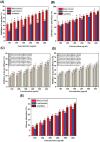Phytochemical analysis, identification of bioactive compounds using GC-MS, in vitro and in silico hypoglycemic potential, in vitro antioxidant potential, and in silico ADME analysis of Chlorophytum comosum root and leaf
- PMID: 39345858
- PMCID: PMC11427758
- DOI: 10.3389/fchem.2024.1458505
Phytochemical analysis, identification of bioactive compounds using GC-MS, in vitro and in silico hypoglycemic potential, in vitro antioxidant potential, and in silico ADME analysis of Chlorophytum comosum root and leaf
Abstract
Chlorophytum comosum is a plant with medicinal potential traditionally used to treat different diseases. The present study aimed to determine the bioactive compounds, hypoglycemic and antioxidant potential of C. comosum root and leaf. The ethyl acetate extracts of C. comosum root and leaf were analyzed by GC-MS to determine the bioactive compounds. The hypoglycemic potential of the extracts was evaluated by α-amylase, α-glucosidase, glucose diffusion inhibitory assays, and glucose adsorption assay. The ethyl acetate extract of C. comosum root inhibited α-amylase, α-glucosidase, and glucose diffusion in a concentration-dependent manner with IC50 values of 205.39 ± 0.15, 179.34 ± 0.3 and 535.248 μg/mL, respectively, and the leaf extract inhibited α-amylase and α-glucosidase enzymes with IC50 values of 547.99 ± 0.09, and 198.18 ± 0.25 μg/mL respectively. C. comosum root and leaf extracts also improved glucose adsorption. Heptadecanoic acid and dodecanoic acid were identified as potential compounds with hypoglycemic properties through molecular docking. The extracts were also assessed for their antioxidant activity using DPPH, ABTS, and FRAP assays. C. comosum root and leaf extracts were also able to scavenge DPPH radicals with IC50 values of 108.37 ± 0.06 and 181.79 ± 0.09 µM and ABTS radicals with IC50 values of 126.24 ± 0.13 and 264.409 ± 0.08 µM, respectively. The root and leaf extracts also reduced the ferricyanide complex to ferrocyanide with higher reducing powers of 2.24 ± 0.02 and 1.65 ± 0.03, respectively. The results showed that the ethyl acetate extract of C. comosum root has significant antioxidant and hypoglycemic potential compared to the leaf extract. Thus, it can also be studied to isolate the potential compounds with antihyperglycemic activities.
Keywords: Chlorophytum comosum; GC-MS; antioxidant; hypoglycemic; molecular docking; phytochemical.
Copyright © 2024 Kavya, Theijeswini and Gayathri.
Conflict of interest statement
The authors declare that the research was conducted in the absence of any commercial or financial relationships that could be construed as a potential conflict of interest.
Figures









Similar articles
-
Chemical Profiling of Chlorophytum comosum (Thunb.) Jaques by GC-MS/LC-ESIMS and its Antiproliferative Effects on Human Carcinoma Cell Lines.Anticancer Agents Med Chem. 2021;21(13):1697-1707. doi: 10.2174/1871520620666201123085300. Anticancer Agents Med Chem. 2021. PMID: 33231161
-
Phytochemical analysis and antidiabetic potential of Elaeagnus umbellata (Thunb.) in streptozotocin-induced diabetic rats: pharmacological and computational approach.BMC Complement Altern Med. 2018 Dec 13;18(1):332. doi: 10.1186/s12906-018-2381-8. BMC Complement Altern Med. 2018. PMID: 30545352 Free PMC article.
-
Comparative Study of Leaf and Rootstock Aqueous Extracts of Foeniculum vulgare on Chemical Profile and In Vitro Antioxidant and Antihyperglycemic Activities.Adv Pharmacol Pharm Sci. 2020 Sep 1;2020:8852570. doi: 10.1155/2020/8852570. eCollection 2020. Adv Pharmacol Pharm Sci. 2020. PMID: 32954350 Free PMC article.
-
Crude extract and isolated bioactive compounds from Notholirion thomsonianum (Royale) Stapf as multitargets antidiabetic agents: in-vitro and molecular docking approaches.BMC Complement Med Ther. 2021 Oct 27;21(1):270. doi: 10.1186/s12906-021-03443-7. BMC Complement Med Ther. 2021. PMID: 34706708 Free PMC article.
-
Scrophularia lucida L. as a valuable source of bioactive compounds for pharmaceutical applications: In vitro antioxidant, anti-inflammatory, enzyme inhibitory properties, in silico studies, and HPLC profiles.J Pharm Biomed Anal. 2019 Jan 5;162:225-233. doi: 10.1016/j.jpba.2018.09.035. Epub 2018 Sep 18. J Pharm Biomed Anal. 2019. PMID: 30268023
Cited by
-
Bioactive fraction isolated from Curcuma angustifolia rhizome exerts anti-diabetic effects in vitro, in silico and in vivo by regulating AMPK/PKA signaling pathway.Front Pharmacol. 2025 May 14;16:1570533. doi: 10.3389/fphar.2025.1570533. eCollection 2025. Front Pharmacol. 2025. PMID: 40438603 Free PMC article.
-
Quantum-inspired computational drug design for phytopharmaceuticals: a herbal holography analysis.J Mol Model. 2025 Jun 13;31(7):188. doi: 10.1007/s00894-025-06412-w. J Mol Model. 2025. PMID: 40512383 Review.
References
-
- Areshidze D. A., Timchenko L. D., Gulyukin M. I., Kozlova M. A., Rzhepakovsky I. V., Semin I., et al. (2016). Hepatoprotective effect of preparations produced from Chlorophytum comosum (L.) at experimental toxic damage in wistar rats. Pharmacologyonline 2, 81–90.
LinkOut - more resources
Full Text Sources
Miscellaneous

